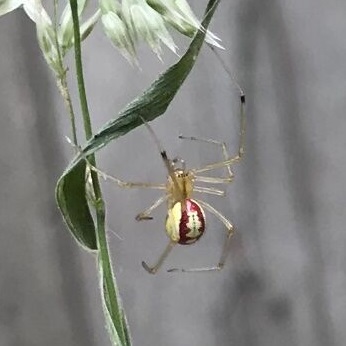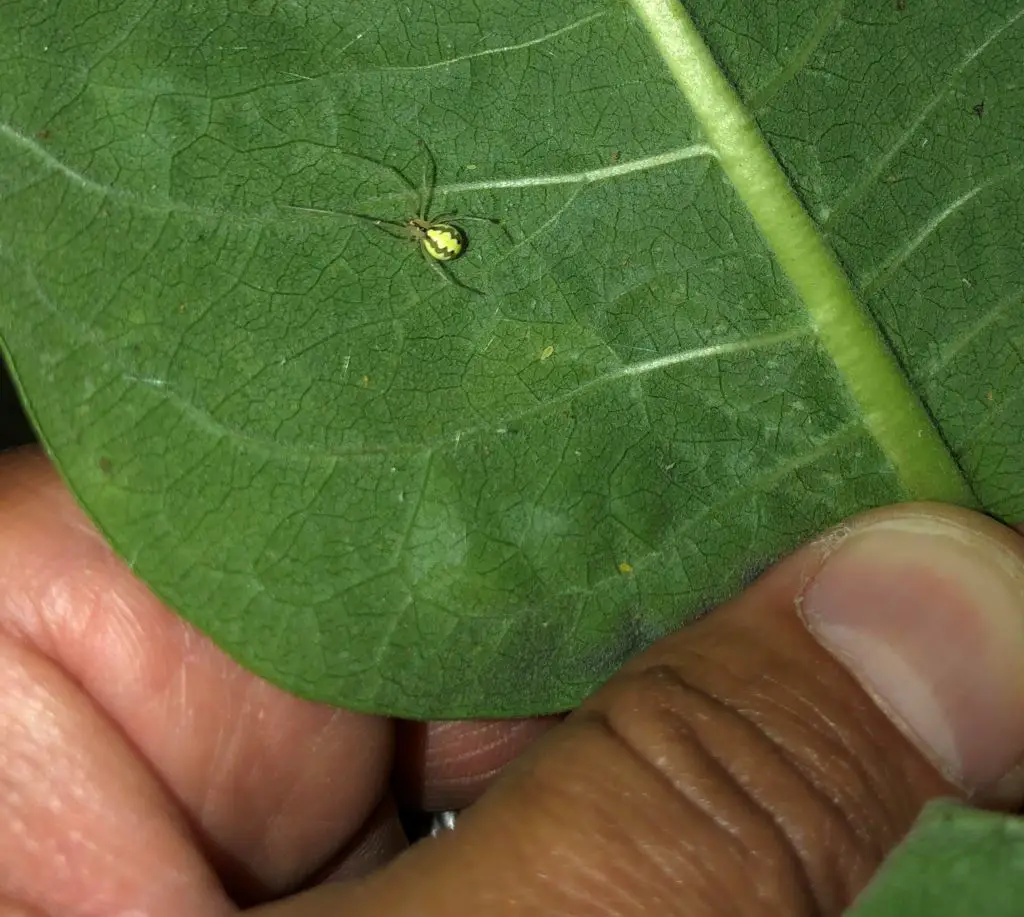Candy-striped spider is not only one of the coolest names for a spider – it also looks great. This spider, which goes by the scientific name of Enoplognatha ovata, is part of the cobweb spider family and has been introduced to the United States and Canada from Europe. Over the last years, its populations have spread throughout the Northern United States. The greenish spider with red stripes along its abdomen is now a common sight along the northern states along the East and the West Coast. Thankfully, this beauty of a spider is not medically significant and does not pose any threat to humans or pets.

Quick Overview: Enoplognatha ovata – Candy-striped spider
Medically significant: No
Body size: 1/4 inch (6 mm)
Main colors: green, white, red, yellow
Range: Northern United States (coast to coast)
Habitat: Mostly found outdoors
Web: Cobweb spider (often observed in plants with no visible web)
Enoplognatha ovata description
Candy-striped spiders are light-colored spiders. Their background color is light brown, yellow, cream-colored or even white. The legs and cephalothorax are normally light brown, orange or greenish and have a translucent appearance. The spider usually has a dark stripe along the middle of its cephalothorax (head).
The abdomen is usually large and round and more colorful than the rest of the body. Candy-striped spiders can come in three different color versions (morphs). The most commonly found in the U.S. is called the redimita form. In this morph, the spider has two red stripes running along the abdomen. The area between the red stripes is usually white or light yellow and can have black spots or stripes.

The red color is not always as strong as in the picture above. In some specimen, the red longitudinal stripes can appear light orange or even brownish.
The second morph, called ovata, has a similar appearance but there is no light area between the red stripes. So there is one large red, orange or brown stripe along the spider’s abdomen. The spider can also come without reddish markings. In the lineata morph, the two red stripes are replaced with a range of black spots.
Male spiders have a more oblong abdomen than females. Their body coloration is usually less bright than the females’.

Note: The closely-related and similar-looking species, Enoplognatha latimana, has also been introduced from Europe to the Northwestern United States. In the color morphs without red in the spider’s body coloration, the two species can easily be confused. E. latimana is also not medically significant.
Size
The body of Enoplognatha ovata grows to an average length of 1/4 in (6 mm). Including their legs, they can be up to three times as long. Males are generally smaller than females.
Web
Candy-striped spiders are part of the cobweb spider family (Theridiidae). They spin tangled and erratic webs to catch their prey. The web of E. ovata is mostly built in or around green plants where their body coloration provides the perfect camouflage. The strands of the web are often very thin and hard to see with the naked eye.
The picture below shows the web of a candy-striped spider with another spider as its victim. Despite their size, they can catch prey that is several times their own body size.

Candy-striped spider bites
Candy-striped spiders are relatively small spiders with small fangs. Since the spider is rarely found inside people’s homes and is generally not aggressive, bites occur very rarely. And even though these cobewb spiders are distant relatives of the black widow spiders, the only have a mild venom. A bite can cause some discomfort like minor local swelling and some local pain, but it is not considered medically significant.
Enoplognatha ovata Scientific Classification
- Kingdom: Animalia
- Phylum: Arthropoda
- Subphylum: Chelicerata
- Class: Arachnida
- Order: Araneae
- Infraorder: Araneomorphae
- Family: Theridiidae
- Genus: Enoplognatha
- Species: Enoplognatha ovata

Distribution of the common candy-striped spider in the USA
The candy-striped spider has been introduced to the Northern United States from Europe. It is found throughout the Northeastern United States as well as in the Pacific Northwest and the states bordering Canada. Namely, it is found in the following U.S. States: Alaska, Colorado, Connecticut, Delaware, Idaho, Illinois, Indiana, Iowa, Maine, Maryland, Massachusetts, Michigan, Minnesota, Montana, New Hampshire, New Jersey, New York, North Dakota, Ohio, Oregon, Pennsylvania, Rhode Island, South Dakota, Vermont, Virginia, Washington, West Virginia, Wisconsin, Wyoming.
Note: One of our readers has sent us an image of a candy-striped spider from Florida. The spider may either have hitched a ride with some cargo or it could mean that the range now extends much farther south than currently assumed. We are always glad for anyone who uploads pictures of their findings so we can update our range information.

Hello Meg, this is most likely a male candy-striped spider (Enoplognatha ovata):
http://amazingnature.us/spiders/candy_stripe_spider2.html
It’s not medically significant.
This spider in Norman, OK, was tending a delicate orb web about a foot in diameter on my back patio. It was about 1/2 inch long, and this is obviously zoomed way on on macro. Another one was on the front of my house, webbing between two brick corners. I haven’t yet found abdominal markings quite like this online. What species of spider is this? Thanks!
Hello Roger, thanks for getting in touch! This is an orchard orb weaver (Leucauge sp.). It’s not medically significant: https://usaspiders.com/leucauge-venusta-orchard-spider/
Seek told me this little lady on my habanero plant is a Common candy stripe spider. I am not familiar with different spiders, but I dig in a little out of curiosity. She is building a “nest” rolling up in a leaf. Her name is Jenny. Because reasons.
Hello Breannah, thanks for getting in touch! This beauty is a candy-striped spider (Enoplognatha ovata). It’s not medically significant. You can read more about it here:
https://usaspiders.com/enoplognatha-ovata-candy-striped-spider/
We took the liberty of using your photo in the article, giving you credit by your first name. Let us know if that is not ok. Cheers!
Hey there! I’ve recently seen many of these pop up around my garden in Fort Collins, CO. This is the first year I’ve ever seen this spider. For what it’s worth, my neighbor just moved here from Lithuania… not sure if they could have hitched a ride but another website mentioned they are most native to that country. Could you confirm? They are very alarming and like your article said, appear similar to the black widow but hidden within our organic garden
Thank you!
Hello Nicole, thanks for getting in touch and for uploading this great shot! Candy-striped spiders have spread a lot throughout the U.S. over the last years. It is possible that the spider came along from Lithuania, where it is very common, with your neighbor, but I think it’s more likely that it is part of the now “native” population in the U.S. that is now expanding further south.
I will update our range information and include Colorado as one of the states where the spider is now also found.
Hi, my kids and I love your website. We recently found this spider (that we think is a candy stripped spider) indoors at a cottage in North Frontenac, Ontario, Canada. Could you let us know if it is a candy striped spider? We caught it indoors and released it under some nice green leaves.
Thanks!
Hi Ana, thanks for the kind words 🙂
This spider is a crab spider of the family Thomisidae. I can’t ID the genus but it’s definitely related to this one here: https://usaspiders.com/misumena-vatia-flower-crab-spider/
Is this a candy striped spider. Found near Ann Arbor Michigan.
Hi Janice, this is an orchard spider (Leucauge sp.): https://usaspiders.com/leucauge-venusta-orchard-spider/
I’m in New Mexico and I noticed this beauty on my screen door. This is the first time I’ve ever noticed this spider. I was concerned by the spindle-y legs, as I tend to associate those with the less safe spiders here, so I ran it through a bug identification app which is telling me it’s a Candy Striped Spider. I figure it’s not a bad idea to see if you all can identify it and I’m always happy to contribute new data. I’m hoping the picture quality isn’t too bad (I took it from inside the house, behind the glass door).
Found this on wrapping its meal today.
Found this little one in my Pea vines. I think it is a Candy stripe but not sure. Just wanted to share it with others.
I forgot to mention with my last picture that I live in the Black Hills of SD.
I went out this morning after work to water/fees my garden and I found this very vibrant Candy Stripe Spider relaxing in my Cucumber plants. I left the pretty little thing to help control the Cucumber Beetles and what not.
I think this is a candy Stripe spider. Found rolled up in a dead nasturtium leaf with a large egg sac.
This was today on my recycle bin. I noticed California was not of the list of areas it is found. She is a beauty and the first I’ve seen here in Eureka, Humboldt County, CA.
Krystal here from WI. Just saw this guy for the 1st time ever in my life! I hate spiders but he’s beautiful!! Found him on our umbrella in our breeze way going into our house. Eeeek! Haha but he really is very pretty
Hi. My home town is Brighton, Sussex, England. I found this candy striped spider and egg sac in my kitchen, attached to the bottom of a coffee container. Some of the babies have hatched. I have relocated everything to a container in my garden.
Found south of Wellsville, NY. Nice red candy stripes
Found on my yellow zucchini today in Seattle Washington
This little buddy hitched a ride on my tackle box at a boat launch in northeast Michigan. So pretty!